掌握個人CFC報稅五大步驟,輕鬆迎接新制上路
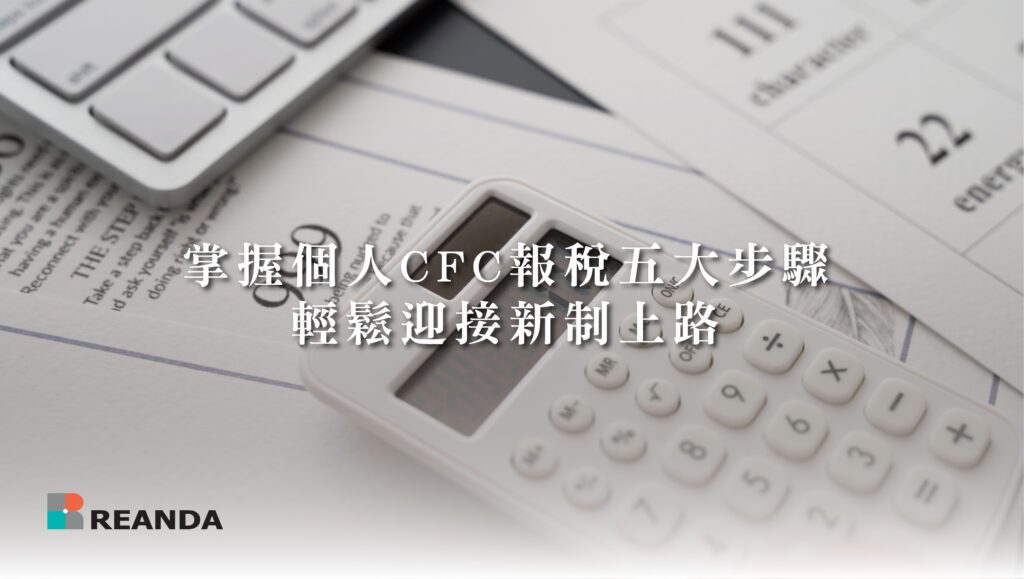
掌握個人CFC報稅五大步驟,輕鬆迎接新制上路 May 13, 2024 隨著2024年5月綜所稅申報期的到來,今年個人所得稅最大變革在於新增了「個人受控外國企業」(CFC)的課稅制度。對於持有境外低稅負公司的個人來說,這將可能產生實質影響。 本所彙整個人CFC報稅的五大步驟要領,讓納稅人能夠有條不紊地完成 CFC 所得的申報: (一)確認是否持有CFC公司 在申報個人基本稅額時,需另外填列持股明細表、關係人結構圖、CFC營利所得計算表等表格。對於是否有經會計師簽證的CFC公司財報,納稅人務必提早評估並準備。 (二)填列CFC相關申報表單 在申報個人基本稅額時,需另外填列持股明細表、關係人結構圖、CFC營利所得計算表等表格。對於是否有經會計師簽證的CFC公司財報,納稅人務必提早評估並準備。 (三)判斷CFC公司是否達豁免門檻 只要CFC公司盈餘未達700萬元,或在當地有實質營運活動(且被動收入低於10%),可豁免計入個人最低稅負,但仍須申報CFC公司資訊。 (四)計算CFC營利所得 CFC營利所得的計算方式較為複雜,必須先算出CFC當年度盈餘,再扣除限制分配的部分和過去虧損。此外,對於CFC公司持有金融商品的公允價值變動,也有特殊的申報方式。 (五)檢附CFC相關佐證文件 除了申報表單外,納稅人尚須檢附CFC公司的財務報表、轉投資事業證明文件,以及持股變動、金融工具處分等佐證資料。部分文件雖在申報時無需提交,但日後稽查時必須備妥。 由於2024年是CFC制度首次實施,本所提醒納稅人更應提早做好準備,或尋求專業協助,以免在報稅時來不及備齊所需文件,遭受補稅或裁罰的風險。掌握好這五大步驟,以確保CFC所得順利申報!
越南稅務及房地產投資法令新知

越南稅務及房地產投資法令新知 April 17, 2024 2023年11月28日,越南國會頒布了第29/2023/QH15號房地產業務法(2023 Law on Real Estate Business, REB Law 2023),該法將取代2014年11月25日頒布之現行第 66/2014/QH13 號房地產業務法(REB Law 2014)。 REB Law 2023 將於2025年1月1日生效,預計將對越南市場之房地產業務投資和營運產生重大影響。 主要更新內容為以下八個要點: (一)對市場上的房地產類型進行補充 REB Law 2023 補充兩類市場上的房地產類型,包括: 1) 現有或未來建成的建築工程中之建築面積; 2) 房地產專案中具有技術基礎建設之土地使用權。 REB Law 2023 也明確規定投入市場之建築工程類型,包含旅遊、住宿和混合服務功能之建築工程。雖然只提供相關建築工程類型的一般規定,但也為營運公寓式飯店或辦公式飯店的開發專案提供一套清楚的法律框架。 (二)房地產開發商須揭露之資訊要求 REB Law 2023 要求經營房地產開發商揭露更多且更詳細之資訊和文件。REB Law 2023 明確要求房地產開發商公布所有重要專案之許可證,包括投資政策決定、土地分配或土地租賃決定、核准之詳細計畫書和標準合約等。 資訊揭露時間:在房地產或房地產專案銷售之前。 資訊應被揭露於兩處: 建設部之房屋及房地產市場資訊系統 房地產開發商的官方網站 (三)房地產開發商之資本限制 房地產開發商執行經核准之開發專案於投資20公頃以下之土地時,其公司股東的出資額(Equity)比例不得低於該專案總投資資本之20%;於投資20公頃以上之土地時,公司的出資額比例不得低於該專案總投資資本之15%;且必須確保投資專案實施之「募資能力」。對於一次起造複數專案的開發商,該公司必須保證每個專案都有依上述比例分配足夠的股東出資額。該法規被視為是根據2022年1月6日第02/2022/ND-CP號法令為 REB Law 2014 內的部分規定細節進行更新。 此外,房地產開發商也必須確保貸款金額與股本金額,以及發行在外公司債與股本金額之比例符合規定。不過,REB Law 2023 並未明確列明具體比例,還需待越南政府的進一步指示。 (四)擴展外商投資經濟組織房地產業務之形式 REB Law 2023 使用「外國投資經濟組織」一詞,取代 REB Law 2014 使用之「外資型企業」。 REB Law 2023 讓外國投資人更容易投資越南房地產,尤其新增外國投資經濟組織之房地產公司類型,可使外國投資經濟組織不受2020年投資法(外國投資者之要求)的條件與程序約束,允許其如同國內機構一樣開展房地產業務。相較之下,若外資投資經濟組織受《外國投資者要求》之約束,則這些組織只能在有限範圍內開展房地產業務,這與 REB Law 2014 之做法相同。 (五)現有房屋和建築房地產專案可於市場銷售之條件 市場上已完工房屋和在建工程可於市場銷售之條件 已完工房屋和在建工程須有合格之所有權證明;證明此類已完工房屋和在建工程已受測試並具資格銷售,且必須完全符合相關財務規定。 開放出售或租賃購買(租購)在建工程之樓層面積 REB Law 2023 明確列出在滿足某些條件之情況下,可開放在建工程之樓層面積出售或租購 犯下行政違規事件的房地產開發商 根據 REB Law 2023,若房地產開發商於投資、建設、土地、住房、房地產經營、稅務等領域受到行政違法處罰,須待相關行政處罰決定全面執行後,方可簽訂房屋、建築工程買賣、租賃或租購合約。 (六)銷售預售屋和建築工程的相關條件 租賃預售建案和建築工程之權利 REB Law 2023 不再明確規定可出租預售建案或建築工程。儘管出售權(或租購)仍然保留,但 REB Law 2023 中刪除了所有有關預售建案和建築工程之租賃規定。 投資者對預售建案和建築工程之押金門檻 REB Law 2023 首次規定房地產開發商向客戶收取之押金上限。押金不得超過預售建案、建築工程或樓層面積之銷售或租購價格的5%。該價格必須明確記錄在押金協議中。 購買或租購預售建案之頭期款及工程款門檻 REB Law 2023 規定,購買或租購預售建案,包括房屋、建築工程和建築面積之頭期款不得超過合約價值的30%,當中包括前項敘述之押金(最多5%)﹐而 REB Law 2014 則未包含該押金金額。 REB Law 2023 規定,購買或租購預售建案、建築工程或建築面積之頭期款及工程款的總額不能超過合約價值的50%,而 REB Law 2014 則規定為70%。 預售建案之擔保為非必要條件 REB Law 2023 允許購買者或租購者可選擇是否要求開發商為其財務義務提供擔保。而根據 REB Law 2014,此擔保為必要條件。 若選擇要求開發商提供擔保,開發商必須於合約簽訂日起10個工作天內或雙方同意之其他期限內提供擔保函。購買者或租購者收到擔保函後,開發商方才能開始向購買方或租購預售方依合約收款 (七)工程轉讓前應繳納相關之稅金及費用 在轉讓全部或部分房地產專案前,開發商必須繳納與該專案相關之稅金或費用,包括土地使用稅、土地租金、土地相關稅和費用,以及就轉讓該專案或部分專案應向國家繳納之費用(如有)。這項新增的規定將提高房地產開發商移轉建設案的門檻。 (八)房地產仲介公司之相關規定 提供房地產仲介服務(Real Estate Brokerage Service, REBS)的公司必須至少有一名具房地產仲介執業證書的員工,而非現行法律要求的兩名人員。 企業提供房地產仲介服務前,應備妥公司簡介並上傳至企業所在地的省級房地產主管機關,並於房屋房地產市場資訊系統上公布。 房地產仲介服務之從業人員必須於房地產交易服務公司或是提供房地產仲介服務之公司工作,從業人員將不能依 REB Law 2014 獨立執行房地產仲介服務。 總結來說,越南的新《房地產業務法》(REB Law 2023)將對市場產生深遠影響,並對房地產業務投資和營運帶來重大改變。這些更新包括對房地產類型的補充、開發商資訊揭露要求、資本限制、外商投資形式擴展、房地產專案銷售條件、預售屋和建築工程相關條件、工程轉讓稅金及費用、以及房地產仲介公司的規定。這些改變將影響越南房地產市場的運作方式和條件,並可能對投資者和業務從業人員產生重大影響。 本所建議密切關注這些法律變化,特別是從事越南房地產業務的專業人士和投資者,以確保業務和投資符合新的法律要求,並做好相應的調整和準備。
境外信託不是CFC的避風港!財政部釐清CFC信託股權課稅疑義
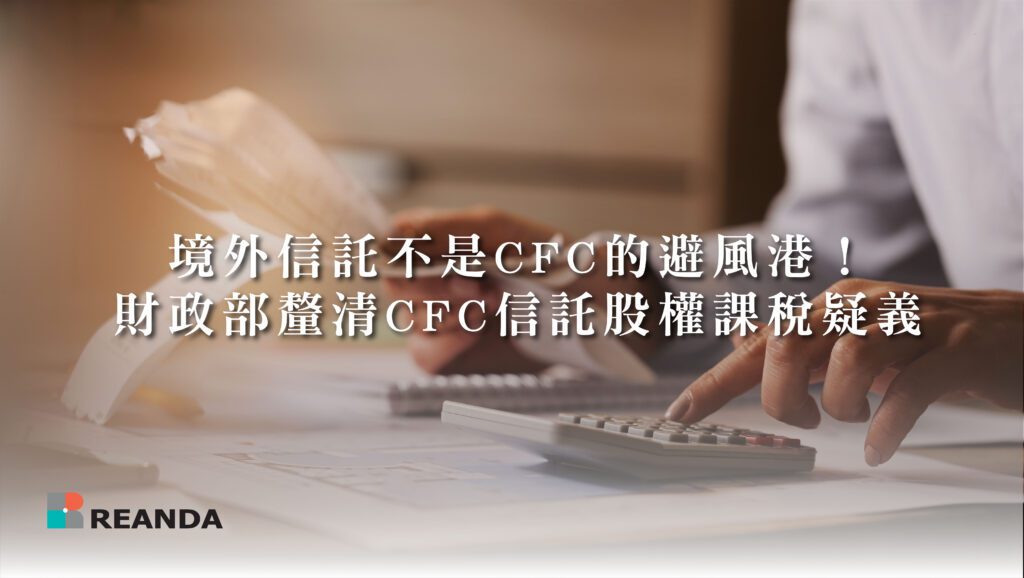
境外信託不是CFC的避風港!財政部釐清CFC信託股權課稅疑義 April 9, 2024 「境外信託」一直是高資產人士規劃財富傳承、家族企業的重要工具。自2023年實施受控外國企業(CFC)制度後,CFC制度對境外信託的影響一直備受關注。在現行 CFC 制度下,透過境外信託架構安排的信託股權可能被認定為個人的CFC,對此仍有許多疑義待釐清。 針對這些問題,財政部於 2023 年 12 月 22 日修正了《個人計算受控外國企業所得適用辦法》,並於 2024 年 1 月 4 日頒布了 CFC 信託課稅函釋,進一步釐清信託股權在 CFC 制度下的課稅疑義。 本篇將概述 CFC 制度的最新修正重點,並進一步解析境外信託架構下的個人 CFC 申報適用規定及納稅義務,以協助納稅人早日因應與安排。 常見境外信託架構安排 由於擁有資產保護、反強制繼承權、協助家族企業永續控股等多重優勢,境外信託對於擁有跨境財產和家族企業的高資產人士而言至關重要。因此,境外信託架構設計在家族企業和財富傳承規劃中是一個重要課題。境外信託架構通常包括委託人、受託人、受益人和信託契約等組成部分,常見的分類型態如下: 以信託契約是否可變更或終止,分為:可撤銷信託(Revocable Trust)、不可撤銷信託(Irrevocable Trust) 以受託人是否有決定分配信託利益之權利,分為:固定利益信託(Fixed Interest Trust)、全權裁量信託(Discretionary Trust) 以受益人身分是否與委託人為同一人,分為:自益信託(Self-benefit Trust)、他益信託(Other Interest Oriented Trust) 境外信託架構下,信託業者(受託人)通常不會直接持有信託股權,而是在其下成立附屬管理公司,由附屬管理公司持有委託人的信託股權。 信託關係下之關係人範圍 依據修正後之個人CFC辦法規定,信託關係下之關係人(包括關係企業及關係企業以外之關係人)包含: 個人與營利事業屬同一信託關係之委託人、受託人或受益人,且該信託關係之信託財產為低稅負區關係企業股份或資本額。但受託人為其所在租稅管轄區主管機關許可之信託業者,該受託人視為非關係企業。 與個人屬同一信託關係之委託人、受託人或受益人,且該信託關係之信託財產為低稅負區關係企業股份或資本額者,其委託人、受託人或受益人本人、配偶及二親等以內親屬。 個人CFC辦法修正後,在符合上列但書規定下,受託人(信託業者)將有機會可自關係人範圍中排除。此外,與修正前之個人CFC辦法相比,除了委託人、受託人、受益人應互為關係人外,也擴大範圍包含他們的配偶及二親等以內親屬,亦應特別加以留意。 境外信託CFC課稅解析 根據財政部發布的CFC信託課稅函釋精神,基本上是遵循信託穿透課稅觀念,並將對信託財產經濟利益的實質受益人進行課稅。換句話說,委託人無法透過境外信託架構來規避CFC制度,納稅人應該特別注意這一點。 財政部CFC信託課稅重點整理 委託人之信託股權,不計為受託人之直接持有比率 CFC認定方式,根據孳息受益人情況而有所不同: 孳息受益人已確定且特定者「孳息受益人及其關係人」直接或間接持有低稅負區關係企業之股權合計達50%或對其具有控制能力者,該低稅負區關係企業為孳息受益人之CFC。 孳息受益人未確定者(註1)以委託人為孳息受益人。因此,「委託人及其關係人」直接或間接持有低稅負區關係企業之股權合計達50%或對其具有控制能力者,該低稅負區關係企業為委託人之CFC。 直接持有低稅負區關係企業股權比率之計算方式如下: 信託股權之個人CFC營利所得計算方式:以CFC當年度盈餘按上述計算之「信託股權直接持股比率」及當年度信託期間,予以計算個人CFC營利所得。 註1:如信託契約未明定特定之受益人,亦未明定受益人之範圍及條件;或委託人保留變更(指定)受益人或分配、處分信託利益之權利。 註2:以信託行為明定或可得推知之比例為準;其比例不明或不能推知者,按孳息受益人人數平均計算之 總結 根據財政部最新修正的個人 CFC 辦法和 CFC 信託課稅函釋,信託形式和態樣將根據信託契約內容而有所不同,其涉及的稅務影響和複雜度也各有不同。因此,除了應留意個人 CFC 稅務風險外,也應重新檢視個人境外信託架構是否存有其他稅務風險(例如遺產稅、贈與稅、所得稅) 在 CFC 制度實施後,個人將無法再透過境外信託架構安排境外公司股權而享有稅務遞延的效益。本所建議個人應尋求專業會計師協助,儘快檢視個人現有的境外信託架構,對個人境外信託架構和信託契約內容進行全面的稅務健檢,並及早評估可能的稅務風險,制定相應的因應措施和準備。
臺商投資美國稅負 會計師的「解盲三法」

臺商投資美國稅負 會計師的「解盲三法」 Mar 27, 2024 臺灣與美國稅收減免法案(以下簡稱臺美稅收減免法案)提供較低的扣繳稅率,對比美國較高有效來源所得課稅門檻,目前利於降低國內公司未來在美整體稅負,對於臺商投資整體策略而言,仍須透過專業稅務技巧來做因應。 美國想要增加外國企業赴美投資誘因,必須有效回應OECD支柱二(Pillar II)實施,反觀臺灣企業為了優化商業模式貼近稅務效率,理應調整相關的投資架構,畢竟它與更具爭議的租稅措施彼此扣連。臺美之間是否需要控股公司,未來必須謹慎考量,針對中間控股公司的經濟實質情況,作為研斷控股公司是否能通過美國適用租稅協定優惠稅率以及租稅協定中的利益限制條款(Limitation on Benefits, LOB)。 本所吳明儀會計師表示,臺美稅收減免法案未來在美國參、眾兩院通過之後並送總統簽署,之後為了確保雙方互惠實施執行,臺美還得另外商討簽定國際文書,臺灣也須完成「條約締結法」相關程序,以使租稅優惠生效適用。美國目前針對外國居住者的美國來源股利,課徵「30%」扣繳稅率,根據釋出的草案內容,扣繳稅率有望降至「15%」,例如持有美國公司「10%」以上股權者,扣繳稅率可降低至「10%」,我們可以先就「個人聘僱所得之課稅處理」、「公司機構原則之應用」以及上述提到「利益限制之相關規定」來做分析。 壹.個人聘僱所得之課稅處理 非美國雇主(含代理非美國雇主)於美國支付予合格臺灣稅務居民在其境內 提供個人服務相關報酬、工資或薪水,且非美國雇主在美國之常設機構不須承擔費用,該一臺灣居民不須針對該類所得繳納個人所得稅務,上述所得不適用於支付特定報酬。根據美國所得稅協定範本規定之應稅薪資所得,例如董事酬勞、退休金以及其他日常。 依臺灣居民(稅務原則)上係指因其國籍、管理處所、公司設立及居住地,包含其他類似情況在臺負有納稅義務之企業,必須具備非美國稅務居民企業,針對特定情況援引法案提供相關判定標準作為指引,符合該法案所定義之合格臺灣稅務居民,根據該一法案享受租稅優惠。 貳.公司機構原則之應用 臺灣合格的稅務居民在美國商業活動獲得收入,過去是用美國國稅局中有關有效關聯所得(Effectively Connected Income,ECI)定義判斷是否須課徵美國所得稅,臺灣企業若在美國有ECI,那就代表要在美國課稅。根據該一法案規定,未來僅針對臺灣公司在美國常設機構與ECI有連結時,該ECI才需要課徵美國所得稅。臺灣企業若在美國未設常設機構,便不會被納入課稅對象。 美國所謂常設機構是指臺灣企業於美國從事商業活動有無固定營業場所,別於臺灣有納稅義務的定義範疇,只要是在美國從事商業活動的相關處所,同時涵蓋天然資源開採場所,在其區域上的定義與臺灣繳稅上的定義全然不同。此外,該一法案就是針對暫時性專案判定是否於美國構成常設機構提供相關指引,例如專為企業展示或從事其他具有經營性質之活動地點同樣認定營業場所,但不包括臺灣企業於美國所雇的獨立代理人之固定營業場所,即使代理人經常性代表臺灣企業簽訂合約。 參.合格稅務居民的法案定義 即指國籍、管理處所、公司設立、居住地等負有納稅義務之企業,且須為臺灣非美國稅務居民企業,針對特定情況也會提供法案指引,因此相關企業必須注意利益限制要求,合格臺灣稅務居民才能確保符合法案定義,合法享受租稅優惠。 美國也會針對該一法案持續發布相關指引,針對合格臺灣稅務居民以及利益限制定義、申報、扣繳等,對比常設機構定義細則,藉此判斷ECI是否與常設機構之間屬於有效連結。最終,唯有臺灣政府亦於國內法制定相關互惠條款,能使美國稅務居民取得臺灣來源所得,雙邊適用互惠條款,擬議規則才會生效。 吳明儀會計師認為美國參議院這次快速通過臺美稅收減免法案,除了針對特定類型之所得提供扣繳稅率優惠,一併透過法令名詞定義細部規定提供說明,以此提升租稅上確定性。臺商若在美國進行商業行為,認定在營運活動下未定義為常設機構,即便不須針對相關所得繳納美國聯邦所得稅,但仍需留意相關申報事項,以利日後遭遇美國國稅局認定該活動歸屬當地常設機構,確定產生ECI,臺灣企業可就相關成本費用主張進行扣抵。 法案條款內容主要適用於美國聯邦所得稅,即便不會影響美國各州之間的稅務處理,卻因彼此所得計算方式各吹各調,臺商還得留意並且關注該法案對於美國州稅和相關申報的後續影響。吳明儀會計師建議臺商若有美國營運計畫應當密切關注,立法後續雙邊締結的相關合約,企業務必尋求專業諮詢了解細則,以利掌握營運配套的節稅計畫。 吳明儀會計師指出臺商投資美國稅負的「策略解盲」,仍須透過專業稅務技巧來做因應,外部來看有效掌握OECD支柱二(Pillar II)實施,研斷控股公司是否能通過美國適用租稅協定優惠稅率以及租稅協定中的利益限制條款。 內部而言,可以了解「個人聘僱所得之課稅處理」、「公司機構原則之應用」以及「利益限制之相關規定」,確定產生ECI的前提下,臺灣企業才能根據相關成本費用主張進行扣抵,如果沒有尋求專業諮詢了解細則,恐在美國各州法令不一的情況下,斷送攸關公司命運的節稅計畫。
產業創新法規激勵企業發展:租稅優惠重點解析

產業創新法規激勵企業發展:租稅優惠重點解析 Mar 26, 2024 產業創新是推動產業升級的重要推手之一。為了減輕企業負擔並推動產業轉型,大部分的產業創新法規(《產創法規》)已延長優惠期至民國118年12月31日。透過各項租稅優惠措施,希望協助企業持續發展,提升整體競爭力。本所針對其內容提出要點解析,提醒企業善用租稅優惠以節省成本。 目前常見的產創法規租稅優惠主要包括:一、公司或有限合夥事業研究發展支出可享投資抵減〔第10條〕;二、公司或有限合夥事業研究發展支出可享加倍減除〔第12條之1第1項〕;三、公司或有限合夥事業投資智慧機械、第五代行動通訊系統、資通安全產品或服務可享投資抵減〔第10條之1〕;四、公司或有限合夥事業實質投資可列為未分配盈餘減除項目〔第23條之3〕;五、公司或有限合夥事業智慧財產權入股可享緩課〔第12條之1第2項〕;六、有限合夥創投事業投資國內新創事業公司可享租稅優惠〔第23條之1〕;七、公司前瞻創新研究發展及先進製程設備支出可享投資抵減〔第10條之2〕。 產創條例租稅優惠 適用對象 適用期限 抵減方式 重複適用租稅優惠限制 一 公司或有限合夥事業研究發展支出適用投資抵減 [第10條] 公司或有限合夥事業 106/11/24~118/12/31 一經擇定不得變更 一、 按支出金額15%,抵減當年度應納營利事業所得稅額 二、 按支出金額10%,自當年度起 3 年內抵減各年度應納營利事業所得稅額 各年度投資抵減金額以不超過當年度應納營利事業所得稅額30%為限 不得就同一事項重複享有本辦法所定之租稅優惠 二 公司或有限合夥事業研究發展支出適用加倍減除 [第12條之1第1項] 個人、公司或有限合夥事業 106/11/24~118/12/31 在其讓與或授權自行研發所有之智慧財產權取得之收益範圍內, 得就當年度研究發展支出金額 200% 限度內自當年度應課稅所得額中減除 就本項及第 10 條研究發展支出投資抵減擇一適用 三 公司或有限合夥事業投資智慧機械或第五代行動通訊系統或資通安全產品或服務投資抵減 [第10條之1] 公司或有限合夥事業 108/1/1~113/12/31 資通安全產品或服務:111/1/1~113/12/31 支出總金額達新臺幣(以下同)100萬元以上、10億元以下 一經擇定不得變更 一、 以支出金額 5% 抵減當年度應納營利事業所得稅額 二、 以支出金額 3% 自當年度起 3 年內抵減各年度應納營利事業所得稅額 各年度投資抵減金額以不超過當年度應納營利事業所得稅額 30% 為限 不得就同一事項重複享有本辦法所定之租稅優惠 四 公司或有限合夥事業實質投資列為未分配盈餘減除項目 [第23條之3] 公司或有限合夥事業 自辦理 107 年度未分配盈餘起 因經營本業或附屬業務所需,於當年度盈餘發生年度之次年起3年內, 以該盈餘興建或購置供自行生產或營業用之建築物、軟硬體設備或技術達 100 萬元, 該投資金額得列為當年度未分配盈餘減除項目,免加徵5%營所稅 無 五 公司或有限合夥事業智慧財產權作價入股適用緩課 [第12條之1第2項] 個人、公司或有限合夥事業 109/1/1~118/12/31 以自行研發所有之智慧財產權,讓與或授權公司自行使用,所取得之新發行股票, 得選擇免予計入取得股票當年度應課稅所得額課稅,一經擇定不得變更 無 六 有限合夥創投事業投資國內新創事業公司租稅優惠 [第23條之1] 創業投資事業 106/1/1~118/12/31 自設立之會計年度起 10 年內採透視個體概念課稅,並得專案申請延長一次,以延長 5 年為限 不適用本條例及其他法律有關租稅優惠之規定 七 公司前瞻創新研究發展及先進製程設備支出投資抵減 [第10條之2] 公司 112/1/1~118/12/31 前瞻創新研究發展之支出得按支出金額 25% 抵減當年度應納營利事業所得稅額,並以不超過其當年度應納營利事業所得稅額 30% 為限; 機器設備投資抵減達 100 億元以上者得按支出金額5%抵減當年度應納營利事業所得稅額,並以不超過其當年度應納營利事業所得稅額 30% 為限; 於同一年度申請核准適用本條之投資抵減,或與本條例或其他法律規定之投資抵減合併適用時,其當年度合計得抵減總額,以不超過當年度應納營利事業所得稅額 50% 為限。但依其他法律規定當年度為最後抵減年度且抵減金額不受限制者,不在此限 前瞻創新研究發展之支出:當年度全部研究發展支出,不得適用本條例第 10 條、第 12 條之 1 第 1 項及其他法律為鼓勵研究發展目的提供之所得稅優惠。 機器設備投資抵減:當年度全部購置機器及設備支出,不得適用本條例第 10 條之 1 及其他法律規定機器或設備投資之所得稅優惠。 產創法規提供多項租稅優惠措施以促進產業創新、提升競爭力,本所建議營利事業應定期檢視自身情況,善加利用這些租稅優惠以節省成本,同時要留意相關規定和限制,以免影響自身權益。
拜登公布2025年度預算案:重點探究稅收調整與國防支出
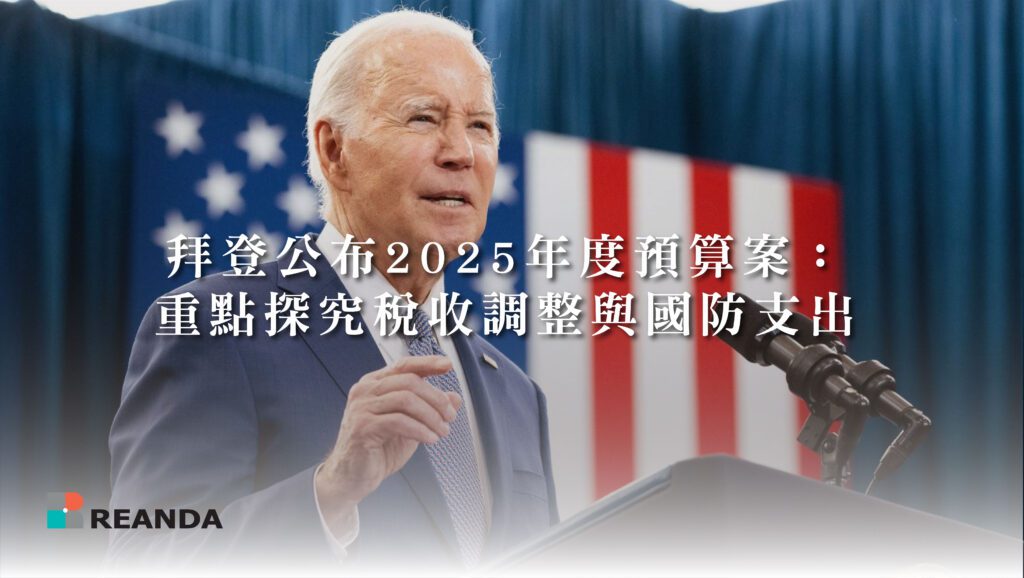
拜登公布2025年度預算案:重點探究稅收調整與國防支出 Mar 22, 2024 拜登於 2024 年 3 月 11 日公佈了2025年度預算草案,計劃將美國企業的最低稅率提高至21%。其中包括修改或實施新的課稅措施。主要措施包括將美國聯邦企業所得稅率從 21% 提高至 28%,將針對年收入超過10億美元的大型企業徵收的最低稅率(即所謂的「CAMT」)從 15% 提高至 21%,對擁有超過1億美元財富的富人徵收至少25%的所得稅,限制年薪超過1百萬美元的任何員工(不僅限於最高管理層)的薪資費用不得在公司帳上扣除,以及將股票回購稅(Stock buyback tax)從 1% 提高至 4%。這些措施反映了拜登對未來美國稅收政策的計劃。 這份規模達 7.3 兆美元的計畫展現他對抗前總統川普並競選連任的決心。拜登計劃透過對富人和企業加稅,以減輕中產階級的稅負並控制價格。預算案中包括國防預算增至 8,500 億美元,較去年增加 1%。此外,美國國務院首次在預算案中撥款 1 億美元,協助台灣強化防衛能力,維護台海和平穩定。 然而,在分裂的國會中,這份預算案幾乎不太可能成為法律。根據英國金融時報(FT)的報導,如果實現,這份預算案將使得美國的債務在 2025 年升至國內生產總值(GDP)的 102.2%,並持續攀升至 2030 年的 106%。這份提案將通過全面修改稅法來籌集資金,包括提高公司稅率、重新設定億萬富翁和大型公司的最低稅率等措施。拜登的預算案也提出了一系列支持措施,包括抵押貸款利率抵減、兒童保育補貼和降低處方藥價格等。 本所將密切關注後續美國稅改的最新動態,並整理分析具體規則和完善配套實施計劃。
銷售賠償金、延遲利息是否納入營業稅?
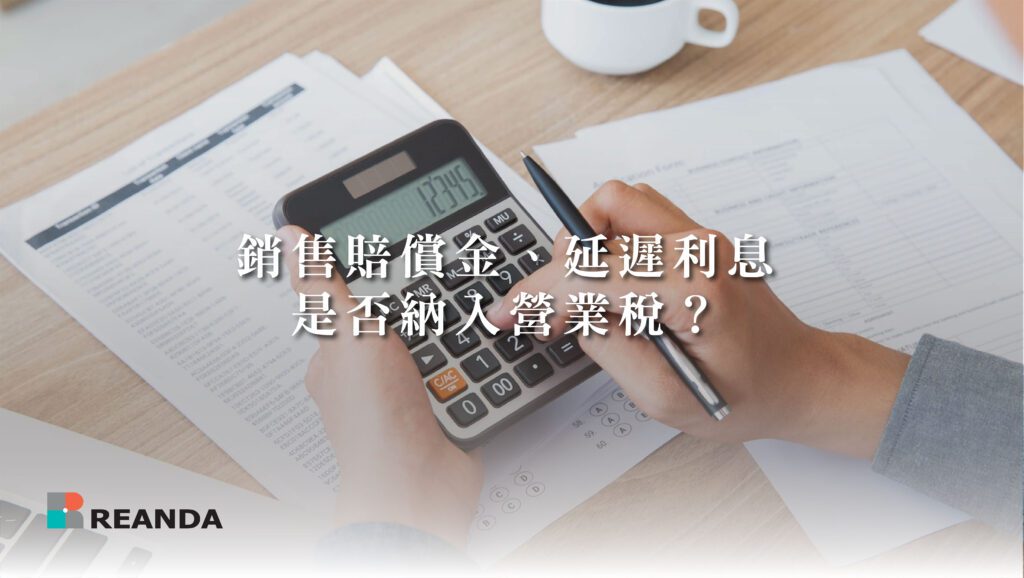
銷售賠償金、延遲利息是否納入營業稅? Mar 19, 2024 有關營業人銷售交易中的付款糾紛和延遲付款問題,財政部於112年12月6日發布了台財稅字第11204662230號令,對法律進行了澄清和修改。根據該令,營業人向買受人收取的遲延利息並不屬於銷售額範圍,並廢止了過去的一些釋令。 本所認為,對於涉及銷售貨物或勞務所產生的賠償金、遲延利息等費用是否應該課徵營業稅,應該要根據收入本質是否屬於銷售貨物或勞務代價的一部分來判定。根據最高行政法院109年度上字第655號判決,遲延利息本質上並非基於給付交換關係,因此不應計入銷售額課徵營業稅。過去的一些營業稅釋令未能區分遲延利息的本質,導致將其一律計入營業稅課稅範圍,這是不合適的。就此,112年12月6日函令的發布將有助於解決這些爭議。 另外,在評估營業人收取的賠償金是否應課徵營業稅時,不能僅僅看其名義,而是需要具體案例中審視是否存在給付交換關係。舉例來說。根據財政部過去的一些解釋,某些賠償金不涉及給付交換,因此不應納入營業稅;但在其他情況下,某些補償金則可能需要納稅。 在商業活動和交易型態日趨多元且複雜化的今天,新型交易模式可能與現有的法令有所不同,因此本所建議在爭議發生前諮詢會計師或與所轄稽徵機關溝通具體案例,以降低營業稅申報的不確定性。
113年「股東常會」召開應注意事項及ESG重要議題
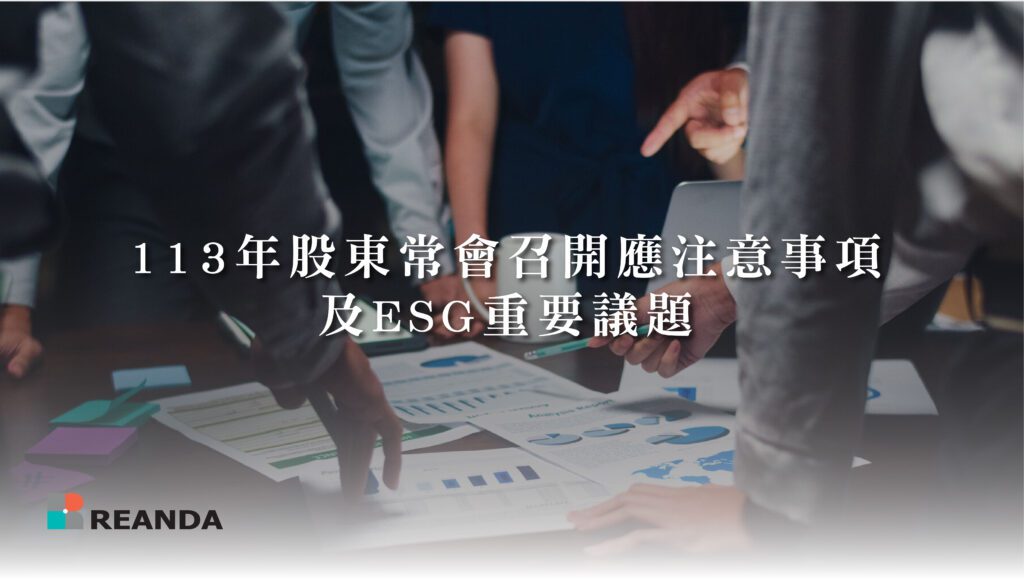
113年「股東常會」召開應注意事項及ESG重要議題 Mar 13, 2024 依法公司應於每會計年度結束後六個月內召開年度股東常會,近年來政府機關為呼應全球永續發展及氣候變遷行動,要求企業應配合揭露相關資訊等行政管理措施之推動,各公司為此應預先規劃及踐行法令規章之遵循,順利展開年度股東常會的籌備工作。 113年股東會議案應注意事項 一、配合興櫃公司董監選舉自 114 年起強制採候選人提名制修改公司章程 為強化公司治理,金管會擴大公司董監選舉應採候選人提名制適用範圍,從原先僅上市櫃公司適用,114 年 1 月 1 日起將擴及至興櫃公司董監選舉同樣必須採候選人提名制。尚未採候選人提名制的公司 113 年需修改公司章程,自 114 年起全數興櫃公司董監選舉將實施候選人提名制。 二、修正股東會議事規則 配合公開發行公司股務處理準則之修正,有需修正股東會議事規則之必要者,應留意提股東會討論修正之法定程序。 三、不符合新修正上市(櫃)公司董事會設置及行使職權應遵循事項要點規定之公司,其補選董事人數或獨董時應注意有無修正公司章程之必要 四、已上市(櫃)之公司之章程應檢視是否應依規定修正章程增加獨立董事席次 依台灣證券交易所股份有限公司上市公司董事會設置及行使職權應遵循事項要點第 4 條/財團法人中華民國證券櫃檯買賣中心上櫃公司董事會設置及行使職權應遵循事項要點第 4 條規定 【董事人數】 董事長與總經理或相當職務者為同一人或互為配偶或一親等親屬者,獨立董事人數不得少於 4 人 董事席次超過 15 人者,獨立董事人數不得少於 5 人,並應有過半數董事未兼任員工或經理人 【設置時間】 現行全體上市公司及實收資本額達新台幣 6 億元以上之上櫃公司應已於 112 年 12 月 31 日前設置完成 實收資本額未達新台幣 6 億元之上櫃公司,應於 114 年 12 月 31 日前辦理修章及補選完成 五、上市(櫃)公司申報揭露股東會議事手冊、年報及會議補充資料等重要資訊 (一)臺灣證券交易所及櫃買中心為配合金融監督管理委員會「金融發展行動方案」之強化英文資訊揭露,規定上市櫃公司申報英文版「股東會議事手冊及會議補充資料」、「股東會年報」及「年度財務報告」電子檔,自 112 年起全體上市公司及最近會計年度終了日之實收資本額達新臺幣 6 億元以上之上櫃公司適用。 (二)金管會修正公開發行公司股東會議事手冊應行記載及遵行事項辦法第 6 條及年報應行記載事項準則第 23 條規定,應於股東常會 30 日前揭露議事手冊等相關資訊之上市上櫃公司適用範圍擴大至實收資本額達新臺幣 20 億元以上或外資及陸資持股比率合計達 30% 以上。另上市上櫃公司實收資本額達新臺幣 20 億元以上者自 113 年起,亦應於股東會召開日 14 日前將年報之電子檔傳至金管會指定之資訊申報網站。 公司治理相關重要議題 一、上市櫃公司永續發展行動方案(ESG) 為持續推動企業積極實踐永續發展,金管會於 112 年 3 月 28 日發布「上市櫃公司永續發展行動方案(2023年)」,以「治理」、「透明」、「數位」、「創新」四大主軸,建構五大面向,包括「引領企業淨零」、「深化企業永續治理文化」、「精進永續資訊揭露」、「強化利害關係人溝通」及「推動ESG評鑑及數位化」等,協助上市櫃公司達成永續發展目標,提升國際競爭力。重點如下: (一)提前上傳股東會議事手冊及年報資訊 (二)推動實收資本額20億元以下之上市櫃公司編製永續報告書 (三)強化獨立董事職能 (四)推動董事性別多元化 (五)強化大量持股資訊之揭露 (六)研訂 ISSB 永續準則推動規畫—金管會發布「我國接軌 IFRS 永續揭露準則藍圖」 二、氣候相關資訊揭露 金管會考量環境議題之重要性及國際間日益關注氣候變遷之相關資訊,爰配合「上市櫃公司永續發展路徑圖」修正年報應行記載事項及公說書應行記載事項,要求上市櫃公司自 113 年 1 月 1 日起應於年報及公開說明書揭露氣候相關資訊(年報應行記載事項附表二之二之三、公說書應行記載事項附表六十三之一),包括分階段達成溫室氣體盤查及確信,以及減量目標、策略及具體行動計畫之揭露,並發布函令金管證發字第 11203852314 號令,明定辦理時程。 三、延續執行「公司治理3.0-永續發展藍圖」重點措施 (一)依實收資本額之規模推動上市櫃公司公布自結年度財務資訊,並縮短查核後年度財務報告公告申報期限。上市櫃公司實收資本額未達 20 億元者,亦應於 113 年 3 月 16 日前公告 112 年度自結之財務資訊;另實收資本額達 100 億元以上之上市櫃公司,依規定應於 113 年 3 月 16 日前公告申報 112 年度查核後財務報告,其餘之上市櫃公司維持於年度終了後 3 個月內申報。 (二)推動上市櫃公司每季財務報表需經審計委員會同意。 (三)推動會計師事務所揭露審計品質指標(AQI)。 (四)強化上市櫃公司永續報告書(Sustainability Report or ESG Report)資訊揭露。 (五)強化董事職能。 (六)強化上市櫃公司股東會運作。 四、公告 113 年度(第十一屆)公司治理評鑑指標 臺灣證券交易所 112 年 12 月 23 日發布「113年度(第十一屆)公司治理評鑑指標」,共計四大構面 75 項指標,適用期間為 113 年 1 月 1 日至 12 月 31 日,並預計於 114 年 4 月底前公布 113 年度之評鑑結果。 第十一屆評鑑修正係依循主管機關公告之「上市櫃公司永續發展行動方案(2023年)」及「資本市場藍圖」,並參考國內外公司治理及永續發展趨勢、法規、政策及各界回饋意見,總計新增 4 項指標、刪除9項指標、修正 7 項指標,以持續促進企業對於各項公司治理機制之重視。 證交所近年來持續引導公司落實永續發展,已陸續增加「推動永續發展」構面指標,並將權重逐年提升,迄本屆已成為配分比重最高之構面。為進一步鑑別上市櫃公司於 ESG 各面向表現,並提供投資人進行ESG 投資決策之參考,已研議規劃以現行「公司治理評鑑」架構為基礎,參考國際推動環境及社會面向之趨勢,期能循序漸進於 115 年轉型為「 ESG 評鑑」。 綜上為利安達平和 永續部彙整113 年股東常會召開應注意事項、永續發展行動方案等重點議題,應予充分了解並配合遵循辦理,並考量公司永續經營之目標需求,事先為最適應之安排規劃準備。
「跨境」電子發票開立-政府因應之道

「跨境」電子發票開立-政府因應之道 Mar 1, 2024 臺灣隨著數位經濟蓬勃發展,傳統紙本發票目前卻仍成為國內主流之一,當國際間逐漸倡議「跨境」電子發票,打造開立、傳輸、交換、保存之標準化流程,吳明儀會計師提醒企業應持續密切關注國際動向,針對電子發票機制及數位化申報法規標準,以利評估公司稅務規劃,未來能與國際規範無縫接軌,政府也該在「跨境」電子發票開立的議題上超前佈署。 各國稅務機關目前積極尋求採用數位化之方式,用以蒐集、評估及查核納稅義務人之相關資訊,例如以人工智慧等工具達到即時徵稅目標,世界各國正在廣泛使用電子發票,也將成為國際貿易「跨境」稅務的憑證依據。目前巴西、印度以及義大利要求所有交易皆以電子發票為主,法國、希臘及挪威則是鎖定企業與政府間的交易。回顧臺灣與美國已經啟動的「21世紀貿易倡議」,包含去年簽署的「臺英雙邊提升貿易夥伴關係協議」,都將觸及數位貿易,也會產生跨國交易,電子發票無疑成為當中關鍵角色。 利安達平和聯合會計師事務所吳明儀會計師表示,跨境電商在臺灣的課稅權將面臨挑戰,將以電子發票使用狀況來做評估,依據財政部2018年7月16日修正公布統一發票使用辦法第7-1條第2款規定,本法第6條第4款鎖定營業人(即境外電商營業人)應開立雲端發票交付買受人。 壹. 境外電商導入雲端發票規劃流程 「中文版 」以及 「英文版」 貳. 境外電商配合於現行消費者交易資訊增加「發票期別」及「發票號碼」,並選擇增列開立雲端發票及歸戶宣導文字。 參. 境外電商選擇於寄送消費者「交易資訊」、「網站」及其他方式,增列開立雲端發票及歸戶宣導文字。 吳明儀會計師提到跨境電商使用電子發票狀況主要在於如何認定在臺灣的「課稅權」,攸關廠商、消費者與政府之間關係,財政部將跨境電商在我國營運類型區分為兩種模式,配合上述國內跨境電子勞務交易課徵營業稅規範: 壹.銷售勞務之實體使用地點歸屬國內: 消費者透過任何形式取得有價票券,不論購買人是否為本國人或外國人,包含展覽、旅館、演唱會等,使用地點屬於國境之內都歸類境外電商銷售給境內國土自然人範疇,例如Booking.com。 貳.銷售的勞務無實體使用地點: 消費者透過線上串流或傳輸方式購買無形有價票券,不論購買人是否為本國人或外國人,包括購買貼圖、線上遊戲、下載音樂等,使用電腦設備或行動裝置安裝地在國境之內(使用手機號碼國碼為我國代碼886),帳單地址在我國領土或使用境內銀行帳戶付款等,例如OpenSea線上交易市場。 吳明儀會計師認為以稅務規劃的專業觀點,全球超過50多個國家轉向使用電子發票,符合2030年淨零碳排之政策目標,將會制定電子發票的共同規格,期能相互使用發票資訊彼此傳遞,各國實現跨國電子發票,目的在於如同身在國家內部的消費型態。臺灣目前如何加入國際組織以會員國形式合作,透過聯盟方式作為一個共同市場,舉凡內部人才、服務、商品以至資本可以互通,打造宛如在國境之內的單一市場,目前正是政府制定電子發票在「跨境」政策上的國際模式。另外,如何透過單一貨幣,讓會員國的貿易往來都無須由幣值轉換,徹底考量邊境管制的根本問題,才能符合各國稅務機制來開立發票。 壹.政府查稅的行政官箴 臺灣不該成為避稅天堂,綜觀各國稅務機關以「數位化」方式,例如大數據等工具進行查核,能夠及時掌控納稅義務人之相關資訊,落實政府稅收目標。臺灣稅局雖然靈活應用數位科技強化電子化政府運作,希望簡化稅務資訊申報流程,即便節省人力支出以及作業成本,強化稅務查核效率且事半功倍,始終無法促進供需雙方無紙化交易的終極目標。 貳.稅務規劃的企業商道 歐盟正在積極消除各國之間的電子商務障礙,為了建立歐盟數位單一市場,並且改善稅收短少同時提高稽徵能力,還能打擊金融犯罪並逃漏稅,將各會員國之稅務機制進行調和。歐盟提出增值稅數位化(ViDA)打造更具韌性之增值稅制,目前引進數位工具稽徵模式,具體策略包括三類: 一.報告數位化:以電子發票為基礎,即時以數位方式申報增值稅 二.登記一體化:建立歐盟境內單一增值稅登記制度 三.經濟平臺化:對網路平臺提供之住宿以及交通服務上,協助消費者與商家在交易數位商品方便簡易。 臺灣與美國自從2022年啟動「臺美21世紀貿易倡議」,在數位金融上已達成支持「健全個資保護」以及「資料自由流通」的具體共識,對比歐盟與新加坡於2023年建立「數位夥伴關係」,加強「數位技術領域」與「促進數位貿易」,加上臺灣與英國於2023年簽署「臺英雙邊提升貿易夥伴關係協議」,同樣是在數位貿易等議題之下促進合作。 全球目前針對跨國合作議題皆已凸顯「數位貿易」的重要性,由於同時牽涉相關稅務議題引發關注,電子發票無疑成為當中要角,也在電子化等相關計畫下生成「無紙化貿易」。政府應持續密切關注國際上針對電子發票機制及數位化申報之相關發展,以此作為跨境電商的管理架構,也能考量國家內部資訊系統與國際電子發票標準化的適用性與安全性,否則臺灣已跟如此多的世界強國攜手合作,最終恐怕只是淪為紙上合約。 政府必須在「跨境」電子發票開立的議題上超前佈署,而非只是針對數位與否來做關注,財政部已有頒布境外電商營業人的開立法規,也有針對「課稅權」認定提出釋疑,最重要是在政府查稅的行政官箴以及稅務規劃的企業商道兩者結合,才能在與其他國家簽訂貿易契約後,真正發揮出經濟綜效。
豪宅認定標準下修 個人112年出售不動產需留意新規定
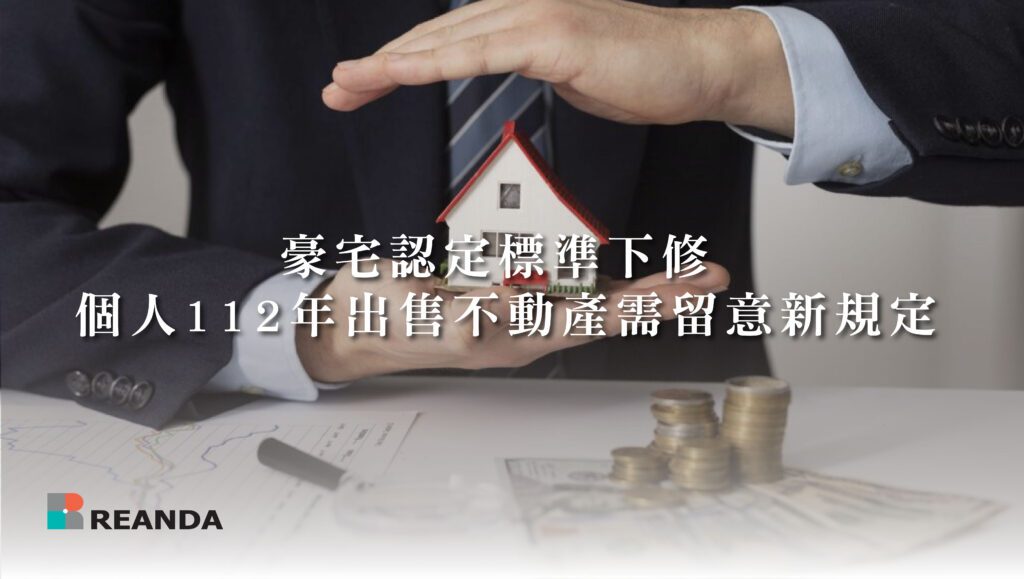
豪宅認定標準下修 個人112年出售不動產需留意新規定 Feb 19, 2024 個人112年度出售舊制課稅房屋(104年底以前取得者),原則上應按售價及取得成本等證明文件核實計算所得,但若僅有出售時的實際成交金額,而無法證明原始取得成本者,在符合上述豪宅標準條件下,稽徵機關將以實際房地總成交金額,按出售時房屋、土地評定現值比例,先計算歸屬房屋之收入,再以該收入的17%計算出售房屋所得額(註:出售舊制課稅土地免納所得稅)。 財政部於2月16日訂定發布「112年度個人出售房屋之財產交易所得計算規定」,下修豪宅認定標準,臺北市及新北市分別為6千萬及4千萬元,桃園市、新竹縣、新竹市、臺中市、臺南市及高雄市為3千萬元。 舉例計算如下:112年度出售臺北市房地總成交金額6千萬元,假設出售時房屋、土地評定現值比例2:8,則歸屬房屋之收入為1,200萬元,乘以17%計算出售房屋所得額為204萬元,應併入綜合所得稅結算申報課稅。 個人在112年度出售的房屋,如果符合舊制課稅的條件,則適用上開的豪宅標準。而對於105年以後取得的房屋土地,則屬於新制課稅範圍。 在新制下,對於個人交易105年以後取得的房屋土地,應以實際成交價格計算房地交易所得,並按照差別稅率進行課稅。換句話說,房地交易所得稅的計算將基於實際成交價格,而不再適用舊制的標準。

